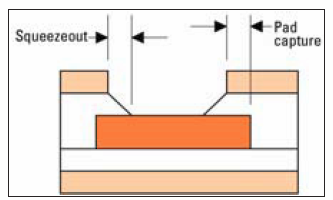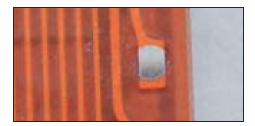II.DESIGN THE RIGHT PAD PATTERN
Another common area WHERE first timers go wrong is in the creation of pad patterns. Flex circuit pad patterns are usually larger than their rigid board counterparts to allow for things that are unique to flex manufacturing, such as adhesive “squeeze-out,” pad capture and cover film mis-registration this is show in Figure 3.
When the cover film is laminated over the etched copper traces, the cover film adhesive layer flows out onto the exposed copper pad, thus reducing the amount of solder-able area. This encroachment of the adhesive onto the copper pad is called squeeze-out. Figure 3is an edge view of a surface
In a flex circuit, the copper trace is affixed to the base film by a layer of adhesive. At elevated temperatures this adhesive softens and loses bond strength. During the soldering process the adhesive can weaken to the point that solder pads lift away from the film. If this happens, the flex circuit is scrap. To prevent lifting, the pads are made larger so that they tuck up under the cover film on opposite ends. The distance the copper extends under the cover film is called pad capture.

Figure 3Example of the flex board Pad

Figure 4Pad captured under the film
Properly created pad patterns for flex circuits are critical for high-yield flex assemblies. Goldphoenix has seen some PCB designers use a quick-and-dirty method in which they take a rigid PCB pad pattern for a component and “flip” the copper pad and the solder-mask openings, making the cover film opening the size of the copper pad and the new copper pad the size of the solder-mask opening. But this method can lead to poor assembly yields because it does not account for adhesive squeeze-out and cover-film mis-registration. What goldphoenix suggest is that try to make the pads as big as possible, since most of the times the flex board is not a high density board.
Section
II.DESIGN THE RIGHT PAD PATTERN
Please login and click here to download the PDF file:


